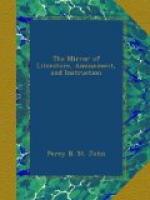“It is a curious fact that toads are so numerous in the island of Jersey, that they have become a term of reproach for its inhabitants, the word ‘Crapaud’ being frequently applied to them; while in the neighbouring island of Guernsey not a toad is to be found, though they have frequently been imported. Indeed, certain other islands have always been privileged in this respect. Ireland is free from venomous animals, of course by the aid of St. Patrick. The same was affirmed of Crete in olden times, being the birthplace of Jupiter. The Isle of Man is said also to be free from venomous creatures. The Mauritius, and I believe one of the Balearic islands, enjoys the same immunity.”
The following anecdote is as pretty as the writer conceives it to be:
“His present Majesty, when residing in Bushy Park, had a part of the foremast of the Victory, against which Lord Nelson was standing when he received his fatal wound, deposited in a small temple in the grounds of Bushy House, from which it was afterwards removed, and placed at the upper end of the dining-room, with a bust of Lord Nelson upon it. A large shot had passed completely through this part of the mast, and while it was in the temple a pair of robins had built their nest in the shot-hole, and reared a brood of young ones. It was impossible to witness this little occurrence without reflecting on the scene of blood, and strife of war, which had occurred to produce so snug and peaceable a retreat for a nest of harmless robins. If that delightful poet of the lakes, Mr. Wordsworth, should ever condescend to read this little anecdote, it might supply him with no bad subject for one of his charming sonnets.”
A few entertaining particulars of
The Royal Parks.
“There are two elm trees, or rather the remains of two, in Hampton Court Park, known by the name of the ‘Giants,’ which must have been of an enormous size, the trunk of one of them measuring twenty-eight feet in circumference.
“Cork trees flourish in Hampton Court Park, where there are two large ones. There are also some ilexes, or evergreen oaks, in Bushy Park, of a very large size, and apparently as hardy as any other tree there. The avenues in that park are perhaps the finest in Europe. There are nine of them altogether, the centre one, formed by two rows of horse-chestnut trees, being the widest. The side avenues, of which there are four on each side of the main avenue, are of lime trees, and the whole length, including the circuit round the Diana water, is one mile and forty yards.
“Near the Queen’s house in this park is a very fine Spanish chestnut tree, said to have been planted by Charles II., and to have been the first which was seen in this country.




